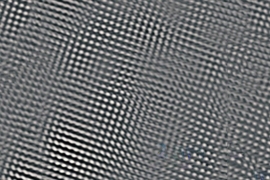MIT researchers have discovered a new mathematical relationship — between material thickness, temperature, and electrical resistance — that appears to hold in all superconductors. They describe their findings in the latest issue of Physical Review B.
The result could shed light on the nature of superconductivity and could also lead to better-engineered superconducting circuits for applications like quantum computing and ultralow-power computing.
“We were able to use this knowledge to make larger-area devices, which were not really possible to do previously, and the yield of the devices increased significantly,” says Yachin Ivry, a postdoc in MIT’s Research Laboratory of Electronics, and the first author on the paper.
Ivry works in the Quantum Nanostructures and Nanofabrication Group, which is led by Karl Berggren, a professor of electrical engineering and one of Ivry’s co-authors on the paper. Among other things, the group studies thin films of superconductors.
Superconductors are materials that, at temperatures near absolute zero, exhibit no electrical resistance; this means that it takes very little energy to induce an electrical current in them. A single photon will do the trick, which is why they’re useful as quantum photodetectors. And a computer chip built from superconducting circuits would, in principle, consume about one-hundredth as much energy as a conventional chip.
“Thin films are interesting scientifically because they allow you to get closer to what we call the superconducting-to-insulating transition,” Ivry says. “Superconductivity is a phenomenon that relies on the collective behavior of the electrons. So if you go to smaller and smaller dimensions, you get to the onset of the collective behavior.”
Vexing variation
Specifically, Ivry studied niobium nitride, a material favored by researchers because, in its bulk form, it has a relatively high “critical temperature” — the temperature at which it switches from an ordinary metal to a superconductor. But like most superconductors, it has a lower critical temperature when it’s deposited in the thin films on which nanodevices rely.
Previous theoretical work had characterized niobium nitride’s critical temperature as a function of either the thickness of the film or its measured resistivity at room temperature. But neither theory seemed to explain the results Ivry was getting. “We saw large scatter and no clear trend,” he says. “It made no sense, because we grew them in the lab under the same conditions.”
So the researchers conducted a series of experiments in which they held constant either thickness or “sheet resistance,” the material’s resistance per unit area, while varying the other parameter; they then measured the ensuing changes in critical temperature. A clear pattern emerged: Thickness times critical temperature equaled a constant — call it A — divided by sheet resistance raised to a particular power — call it B.
After deriving that formula, Ivry checked it against other results reported in the superconductor literature. His initial excitement evaporated, however, with the first outside paper he consulted. Though most of the results it reported fit his formula perfectly, two of them were dramatically awry. Then a colleague who was familiar with the paper pointed out that its authors had acknowledged in a footnote that those two measurements might reflect experimental error: When building their test device, the researchers had forgotten to turn on one of the gases they used to deposit their films.
Broadening the scope
The other niobium nitride papers Ivry consulted bore out his predictions, so he began to expand to other superconductors. Each new material he investigated required him to adjust the formula’s constants — A and B. But the general form of the equation held across results reported for roughly three dozen different superconductors.
It wasn’t necessarily surprising that each superconductor should have its own associated constant, but Ivry and Berggren weren’t happy that their equation required two of them. When Ivry graphed A against B for all the materials he’d investigated, however, the results fell on a straight line.
Finding a direct relationship between the constants allowed him to rely on only one of them in the general form of his equation. But perhaps more interestingly, the materials at either end of the line had distinct physical properties. Those at the top had highly disordered — or, technically, “amorphous” — crystalline structures; those at the bottom were more orderly, or “granular.” So Ivry’s initial attempt to banish an inelegance in his equation may already provide some insight into the physics of superconductors at small scales.
“None of the admitted theory up to now explains with such a broad class of materials the relation of critical temperature with sheet resistance and thickness,” says Claude Chapelier, a superconductivity researcher at France’s Alternative Energies and Atomic Energy Commission. “There are several models that do not predict the same things.”
Chapelier says he would like to see a theoretical explanation for that relationship. But in the meantime, “this is very convenient for technical applications,” he says, “because there is a lot of spreading of the results, and nobody knows whether they will get good films for superconducting devices. By putting a material into this law, you know already whether it’s a good superconducting film or not.”










